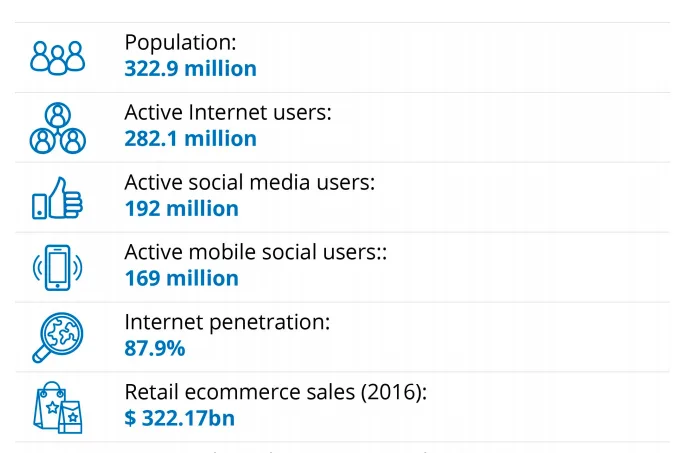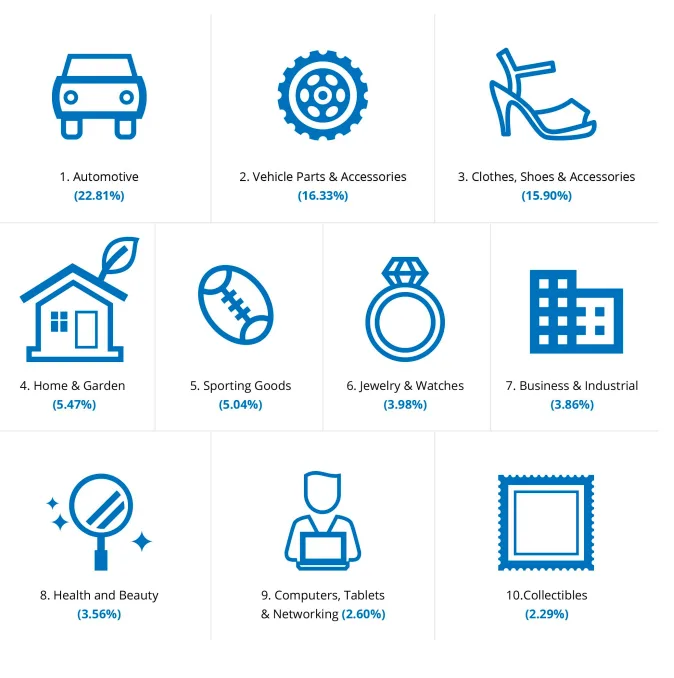Selling To the United States: An Ecommerce Superpower
America is the land of opportunity and a superpower in the world of online sales. It has the world’s largest economy and it’s a global leader when it comes to cross-border ecommerce exports and imports. It’s the birthplace of ecommerce giants, such as eBay and Amazon.
On one hand, the U.S. is a mature marketplace whose growth may possibly slow down in the coming years. On the other hand, U.S. ecommerce sales still lead the Western world. America’s market size, purchasing power, advanced technologies and pure love for online shopping make it an ecommerce hotspot for growth-minded online sellers.
Main characteristics of the American marketplace and consumers
The U.S. is the third largest country in the world and twice the size of the EU. It’s one of the world’s largest consumer markets with high Internet penetration. It’s also a leader in the latest technological releases and innovations.
The power and strength of America entice many foreign businesses to give into the temptation to enter this market, despite the expectedly high entry barriers and strong competition.
U.S. ecommerce market in numbers
282.1 million – Active Internet users
87.9% – Internet penetration
209.6 million – Population shopping online
27% – Proportion of shopping online from both domestic and abroad*

*Source: Statista
Online buying behavior
The U.S. is comprised of savvy, internationally-minded consumers who are well-acquainted with online shopping. U.S. millennials (18-34-year-olds) and females are most likely to buy digitally.
Customer satisfaction and confidence levels are relatively high in the U.S., but so are customer expectations. To a large extent, the U.S. is similar to European marketplaces and European consumer behavior.
The heaviest consumption takes place over the holiday season.
It’s worth remembering the days of the year when U.S. businesses offer big sales deals, e.g. Black Friday, Cyber Monday and holiday periods. These are the times when you can sell much more than during the rest of the year.
It may seem like a given, but don’t forget cultural differences, especially when it comes to communication. Surely, you have an idea of how easy-going the American way can be. However, if your way has always been more hierarchical and formal, being casual may for you in a business context.
Increased awareness of such cultural differences will help you adapt to any foreign market.
This way, you’ll be able to increase your chances of business success, not only in the U.S. but also in other countries.
And what do Americans like to purchase from abroad?
Automotive
Vehicle Parts and Accessories
Clothes, Shoes, and Accessories
Home & Garden

Logistics, deliver and shipping
The U.S. is a large country that boasts high-performance rail networks, highway connections, and air-traffic systems. Its well-developed logistics market has strategic centers in excellent locations.
The preferred shipping options in the United States are UPS and FedEx. Small businesses may also use the government-run postal system (U.S. Postal Service).
The vast majority of U.S. consumers are more likely to make a purchase when free shipping is included. More than half of consumers, in turn, are more willing to buy products when there’s a possibility of free returns and exchanges.
When it comes to cross-border shipping, there are some challenges that need to be taken into consideration. These relate to security and counter-terrorism vigilance, economy and the impact of a recession, and regulations connected with import and trade.
The U.S. customs authorities exercise detailed due diligence so you should ensure timely, correct customs paperwork. The more accurate the customs data, the faster the parcel will be out for delivery.
Payment methods preferred by U.S. online buyers
According to a survey by American Express (September 2016), the most popular payment method among U.S. digital buyers is credit cards. They are used for purchases by 73% of U.S. adult digital buyers and debit cards by 62%. Interestingly, many U.S. consumers are multiple cardholders with nearly five cards per adult.
Mobile ecommerce in the U.S.
The U.S. is ahead of other countries in terms of mobile commerce: mobile is becoming the ultimate ecommerce device. It’s used for researching, connecting with sellers and purchasing. Additionally, cost-efficient mobile rates motivate users to spend more time online.
The mobile share of retail ecommerce sales in the U.S. amounts to 36% (vs. Criteo data: 40% of online purchases made from a mobile device). Even though the U.S. is a bit behind the UK (52%), which ranked first, its position is still strong.
Cross-border shopping
The U.S. is one of the largest cross-border B2C ecommerce markets when it comes to both exports and imports. The most intensive B2C ecommerce trade between the U.S. and the UK is the result of the common linguistic background. A popular destination for online shopping is also China.
U.S. online consumers buy mostly from the UK, China, Canada, Hong Kong, and Australia whereas online merchants sell to China, the UK, Australia, Germany, and Canada.
Benefits and challenges of selling to the U.S.
Benefits
First, America speaks English: the world’s second most popular language and the most popular language online. No wonder that English-speaking marketplaces are the first choice after one’s domestic market! This gives you access to millions of buyers from the U.S. and beyond.
Remember that American English differs from British English, not only in terms of spelling, e.g. American color vs British colour. Among other things, U.S. descriptions tend to be simple and not so idiomatic as in the case of British ones.
Be mindful of the differences in product names, which will also have an effect on the keywords that you should use in your listings.
The second benefit of selling your product in the U.S. has to do with the size and maturity of the market. This translates into access to a very, very large number of online shoppers. Further benefits include online-savvy consumers, well-developed infrastructure and an advanced payment culture.
Third, technology adoption is quick among the U.S. population, which gives online sellers a large number of marketing and communication opportunities, e.g. via social media or apps.
Finally, consider the strength of the U.S. as a country and the notion of the U.S. ecommerce superpower. Many foreign businesses simply can’t help but the target and keep the U.S. in their country portfolio. The market’s sales potential and its leading position seem to outweigh the initial burden of barriers to entry.
Challenges
First, after entering the U.S. market, which is pretty challenging in itself, you must face the challenges of strong domestic competition, changing demographics, rapidly transforming technology and high consumer expectations.
Second, taxes in the U.S. are an exceptionally complex topic with many different state and local sales taxes. Interestingly, some online retailers don’t show the tax owed until the buyer reaches the checkout page. This move, however, may be very risky as a lot of consumers may seeing unexpected extra charges, abandon the shopping cart.
Third, when it comes to the U.S. infrastructure, challenges related to the country size, the variety of landscape and the uneven concentration of population. Logistics challenges may especially affect smaller and mid-sized merchants. They may not have appropriate resources or may not be able to compete without becoming part of a larger distribution organization. This can make their margins suffer immensely.
Fourth, let’s consider the payments ecosystem and security, e.g. credit card authorizations. It’s vital to be able to detect scammers and fraudulent cards. To lower the risk, sellers can require AVS (Address Verification System) on all transactions. This move, however, can make it impossible for buyers to purchase goods from outside of the U.S. if their regions are automatically rejected.
Summary
The American marketplace is large and full of savvy, internationally-minded online buyers. On top of that comes advanced technology, advanced payment culture, and a well-developed infrastructure.
The U.S. is a leader in cross-border ecommerce exports and imports. Finally, the market is full of potential and sales opportunities, e.g. during seasonal events, such as Black Friday or Cyber Monday.
So, even though it may be relatively difficult to enter the U.S. market and stay competitive, once in, your efforts may multiply your revenue and bring business success in a country with one of the strongest economies in the world.

Karolina Kulach is a content marketer at Webinterpret and non-fiction writer, specializing in global ecommerce. Educated in Linguistics (MA) and Business Studies (BA Hons). A well-traveled individual with international education & work experience gained in London, Scotland, Poland and Germany. In her spare time buzzing with creative content ideas, including rhyming poems.


